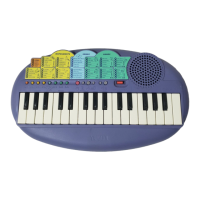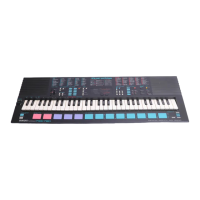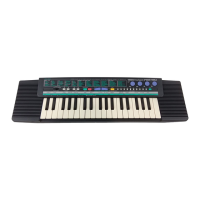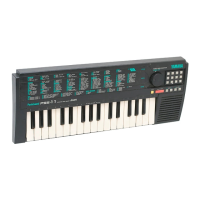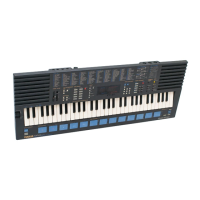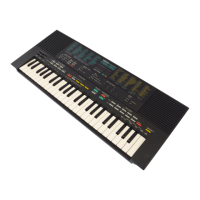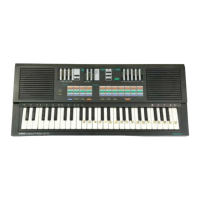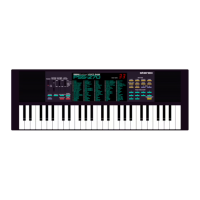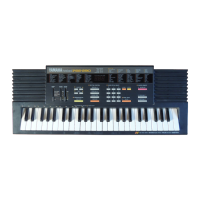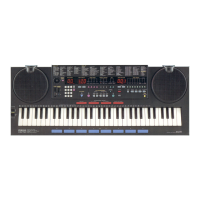
Do you have a question about the Yamaha PortaSound PSS-790 and is the answer not in the manual?
| Effects | Reverb, Chorus |
|---|---|
| MIDI | Yes |
| Display | LCD |
| Type | Portable Keyboard |
| Voices | 100 |
| Rhythms/Styles | 100 |
| Power Supply | 6 x AA batteries or AC adapter |
Important notice regarding product modification and FCC compliance.
Guidelines for using shielded cables and following installation instructions for FCC compliance.
Details product compliance with FCC Part 15 regulations for digital devices.
Statement on digital apparatus compliance with Canadian radio interference regulations.
Special notice for using the product in the Federal Republic of Germany.
Information related to the importer Yamaha Europa GmbH.
Introduces the PSS-790's unique synthesis for natural to hyper-natural sound qualities.
Explains how to create unique sounds by mixing up to 4 AWM Voices using a Joy Stick.
Details the Auto Accompaniment function supporting various music styles and ensemble creation.
Describes the Song Memory function for recording and playback of performances.
Highlights the integrated stereo speakers with Ported Bass Boost.
Lists the 100 pre-set AWM Voices and 50 rhythm patterns available.
Explains the Harmony effect that adds chordal harmonies to musical passages.
Details the 8 Drum Pads for manual percussion playing and sound assignment.
Covers MIDI connectors and the Multi-Timbre mode for playing with other MIDI devices.
Details critical situations that can lead to partial or complete loss of Song Memory data.
Instructions on powering the PSS-790 using batteries or an AC adaptor.
Explains connecting headphones and external amplifiers/stereos.
Basic steps to turn on the unit and set the master volume.
Guide to selecting one of 100 pre-set voices using number buttons and +/-.
Overview of controlling music moods with effects like Harmony, Volume, Vibrato, Reverb.
Introduces the Auto Accompaniment feature and its fingering modes.
Explains how to use the pitch bend wheel to alter pitch.
Describes the three LED displays for viewing current status at a glance.
Details the function to mix up to 4 voices to create custom sounds.
Step-by-step guide to selecting one of the 100 pre-set voices.
Instructions on using the tuning feature to match pitch with other sources.
How to change the musical key of the performance.
How to use the Pitch Bend Wheel for pitch modulation.
Details on applying Reverb to add depth and atmosphere.
How to use the Vibrato effect for musical expression.
Adjusting volume levels for different playing elements.
Explains the 6 Harmony types and their chordal effects.
How to mix up to 4 voices to create custom sounds using the Joy Stick.
Covers selecting styles, starting/stopping, and controlling tempo.
Details Synchro Start, Endings, Fill-Ins, Intros, and Pad Assignment.
Outlines the basic steps and components of Auto Accompaniment.
Explains Single Finger and Fingered modes for chord input.
Details Intro, Large, and Bridge options for arrangement variations.
Lists chords recognized by the Auto Accompaniment feature.
Explains the principles and advantages of multi-track recording.
Details the types of data recordable on each of the 8 tracks.
Step-by-step guides for basic and song recording.
Instructions on selecting and playing back recorded songs.
Explains Clear, Punch In/Out, and Simultaneous Multi-Track Recording.
Defines MIDI and its importance in connecting electronic instruments.
Identifies MIDI ports (IN, OUT, THRU) and connection cables.
Explains Master/Slave setup and data flow via MIDI connections.
Details various MIDI data types like Notes, Velocity, and Program Changes.
Explains how matching MIDI channels enables instrument communication.
Describes the Multi-Timbre feature for playing multiple parts simultaneously.
Guides on setting Receive Channel, MIDI Clock, and Transmit Channel.
Details data transmitted and received, including Note On/Off and Song Memory.
Practical applications of MIDI for PCs, sequencers, and channel voice assignment.
Alerts for low battery voltage and distortion.
Indicates when MIDI channels exceed capacity.
Notifies when MIDI information exceeds processing capacity.
Signals failure in receiving System Exclusive data.
Indicates when Song Memory capacity is reached.
Advice on proper placement and careful handling of the instrument.
Guidelines for using power adaptors and maintaining batteries.
Instructions for cleaning and avoiding electromagnetic interference.
Information on user serviceability and warranty.
Details keyboard size, master controls, and voice selection.
Lists number of voices, rhythm styles, and synthesizer features.
Describes multi-display, voice effects, and overall controls.
Covers MIDI controls, song memory functions, and accessories.
Provides dimensions, weight, power source, and optional items.

